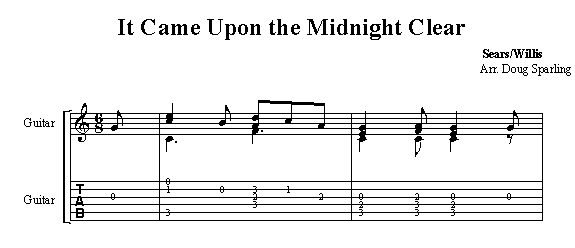It Came Upon A Midnight Clear
It Came Upon the Midnight Clear is one of the best-known American carols, and like many other songs of the season, it has an interesting story to go with it.
The lyrics are based on a poem written in 1849 by Dr Edmund Hamilton Sears (1810-1876), a Unitarian minister who lived in Massachusetts. Sears, a champion of the disadvantaged and downtrodden, wrote the poem while preparing for a Christmas sermon. The poem was published shortly thereafter in the “Christian Register” in December of 1849.
Several melodies have been associated with this carol, including the tune Noel by Arthur Seymour Sullivan (1842-1900), who is perhaps better known as one half of the popular musical writing team of Gilbert and Sullivan. However, the melody now associated with Midnight Clear is Carol, which was written by Richard Storrs Willis (1819-1900). Willis, also from Massachusetts, studied composition in Germany and was a friend of composer Felix Mendelssohn. Willis returned to American in 1848 and later served as a music critic for the New York Tribune and The Musical Times (where he also worked as an editor). Willis somehow came across the Sears’ poem (probably in the Christian Register) and discovered that one of his melodies fit the poem perfectly.
It Came Upon the Midnight Clear was sung during the holidays in World War I by American soldiers in the trenches of France. Midnight Clear was also a holiday favorite at the U.S.O shows of World War II, Bing Crosby being one notable entertainer who sang it for the troops. The song’s message of “Peace on Earth” was one of great poignancy.
Most of this arrangement is in first position and uses familiar chord shapes in the key of C. I use my left hand thumb in a few spots to fret the bass notes on the low E string. In measures three and four, I use my thumb to fret the bass note F, my second finger for the F#, and my thumb again for the G. In measure 11, I use my thumb for the bass note G, and then my second finger for the F# and the subsequent G in measure 12. I also use my thumb for the bass note F in measure seven. In measure nine, I play the second fret E on the fourth string with my third finger. I slide from the E to the F# on the fourth string with my third finger and then stretch with my first finger to play the G# on the third string. In measure 11 I create a harp effect by letting the melody notes ring into one another, which is why I chose to play the C on the fifth fret of the third string instead of on the first fret of the second string.
I hope you’ve had as much fun learning this beautiful Christmas carol as I have. Have a very merry Christmas and happy holidays to all.







